Bulletin – June 2009 The Impact of the Capital Market Turbulence on Banks' Funding Costs [1]
- Download 300KB
Introduction
This article examines the main funding sources used by banks in Australia and provides some estimates of how the financial market turbulence has affected the costs of these sources. It notes that, while the cash rate still has a large influence on banks' funding costs, changes in risk premia in markets over the past two years have weakened this relationship. In turn, this has also weakened the close relationship that has been experienced in the previous decade between the cash rate and banks' interest rates on loans.
Composition of Banks' Funding
Banks operating in Australia fund themselves using a combination of deposits, borrowings in capital markets and equity. This section describes how the costs and the relative importance of the different components of banks' funding have changed as a result of the turbulence in capital markets.
In aggregate, banks operating in Australia currently raise around 43 per cent of their funding from deposits. About 43 per cent of these deposits are sourced from households, 46 per cent from financial and non-financial corporates, and the remainder from governments and non-profit organisations.
Just under half of banks' funding comes from capital markets, with a little more funding raised offshore than domestically. About three-quarters of domestic capital market funding is short term, whereas most offshore capital market funding is long term. A further 4 per cent of banks' funding comes from securitisation; the vast bulk of assets that are securitised are housing loans. Equity accounts for the remaining 7 per cent of banks' funding, and mainly comprises ordinary equity and retained earnings.
The composition of banks' funding was fairly stable over the years leading up to the onset of the financial market turbulence in mid 2007. Since then, the share of securitisation has fallen as there has been virtually no issuance in asset-backed securities (ABS) markets, and the shares of deposits and long-term debt have risen as banks have looked to attract these more stable sources of funding to underpin their strong credit ratings.
The funding mix differs somewhat across banks in Australia (Table 1). The major banks have a slightly larger share of deposit funding than the banking system as a whole (49 per cent versus 43 per cent) with a correspondingly lower share of total capital market funding. Securitisation currently accounts for only 2 per cent of the major banks' total funding, and this share is likely to continue to shrink due to the near-closure of securitisation markets. Historically, the regional banks have relied more on securitisation than other banks, but this funding is being gradually replaced by deposits. The foreign-owned banks have less deposits and correspondingly more funding from domestic capital markets and offshore.
| June 2007 | April 2009 | |
|---|---|---|
| Major banks | ||
| Domestic deposits | 45 | 49 |
| Short-term domestic capital marketliabilities | 16 | 12 |
| Long-term domestic capital market liabilities | 4 | 5 |
| Foreign liabilities | 25 | 25 |
| Equity | 7 | 8 |
| Securitisation | 3 | 2 |
| Regional banks | ||
| Domestic deposits | 43 | 60 |
| Short-term domestic capital market liabilities | 16 | 12 |
| Long-term domestic capital market liabilities | 5 | 5 |
| Foreign liabilities | 14 | 2 |
| Equity | 5 | 6 |
| Securitisation | 18 | 14 |
| Foreign-owned banks | ||
| Domestic deposits | 33 | 23 |
| Short-term domestic capital market liabilities | 26 | 28 |
| Long-term domestic capital market liabilities | 5 | 6 |
| Foreign liabilities | 30 | 41 |
| Equity | 3 | 2 |
| Securitisation | 3 | 0 |
|
(a) The changes in the funding composition of the major banks, regional banks and foreign banks partly reflect merger and acquisition activity in the Australian banking sector. Sources:APRA; RBA |
||
In the remainder of this article we focus on the major banks, largely because there is more public information about these banks' assets and liabilities. In aggregate, the major banks account for about 75 per cent of total banking assets in Australia. The major banks have been less affected by the capital market turbulence than the foreign-owned banks and smaller Australian banks.
Deposits
Deposits can be usefully classified as transaction, savings and term deposits. Transaction deposits encompass the standard statement, passbook and cheque accounts that are used by households and small businesses and are estimated to account for about 17 per cent of deposits, and hence 9 per cent of major banks' funding (Table 2). These deposit accounts have interest rates that are usually close to zero throughout the economic cycle.
| Funding source | Per cent of funding liabilities | Pricing benchmark | Additional costs |
|---|---|---|---|
| Domestic deposits | 53 | ||
| Transaction | 9 | Rates do not change | .. |
| Savings | 26 | Cash rate | .. |
| Term | 18 | Bank bills | .. |
| Capital markets | 47 | ||
| Short-term domestic | 13 | Bank bills | .. |
| Short-term foreign | 7 | Bank bills | Hedging |
| Long-term domestic | 5 | Bank bills/swap rate | Spread |
| Long-term foreign | 19 | Bank bills/swap rate | Spread + hedging |
| RMBS | 2 | Bank bills | Spread + hedging |
|
Sources:APRA; RBA |
|||
Savings deposits are the largest category of deposits, accounting for about half of all deposits or just over one-quarter of total funding. There are a wide variety of savings accounts available to depositors – each of the major banks offer 5–10 different types of accounts. They can be broadly divided into branch-based savings accounts, such as bonus saver and cash management accounts, and online savings accounts.
Bonus saver accounts typically pay a higher rate of interest if at least one deposit and no withdrawals are made each month. These accounts were introduced in the late 1980s, and are now widely available. Cash management accounts usually offer a tiered interest rate structure, with interest rates rising with the account balance.
The fastest growing form of savings account over recent years has been high-yield online accounts. These accounts were introduced by the foreign-owned banks in the late 1990s, but are now offered by most banks. They generally have no fees or a minimum balance requirement, but typically cannot be used to make payments other than to transfer funds to and from a transaction account.
All of these savings accounts are generally at call, with their interest rates tending to move with the cash rate. Online savings accounts typically offer an interest rate that is close to the cash rate, while rates on bonus saver and cash management accounts are usually 1–2 percentage points below the cash rate.
Term deposits currently account for about one-third of deposits and 18 per cent of major banks' total funding. Most have maturities of one year or less, and the interest rates typically move with bank bill rates. Term deposits have been the main vehicle through which banks have been competing for deposits, as they have sought to reduce their use of short-term capital market funding. In pricing these deposits, it has become common for banks to offer short-term ‘specials’ for particular maturities, with the ‘special’ rates being at least equivalent to money market interest rates with a similar maturity. As a result, interest rates on term deposits can differ markedly for terms that differ only by a month or two. Depositors with flexible investment horizons are able to take advantage of these specials, but the maturities to which the specials apply change regularly. Banks typically roll customers' maturing term deposits at the original maturity unless advised otherwise, and so depositors need to manage the maturity of their term deposits actively in order to continue to receive these higher rates.
Capital markets
Borrowings from capital markets can be short term or long term, and are sourced across different currencies, in private and public placements, and in structured and non-structured issues.
The major banks issue about three-fifths of their short-term capital market debt in Australia, mainly in the form of bank bills and certificates of deposit. The market for short-term bank debt in Australia is large and liquid, with about $430 billion of securities currently outstanding.
The banks' offshore short-term debt is issued in a range of currencies, including US dollars, UK pounds and euros, though banks hedge foreign currency debt back into Australian dollars using forward foreign exchange contracts. This allows banks to raise funds in the deep offshore capital markets to support their domestic lending, without taking on the associated currency risk. Domestic short-term interest rates such as the 30-day and 90-day bank bill rates typically provide a reasonable indication of the (post-hedging) cost of this funding.
The major banks access a diverse range of markets for their long-term capital market debt. About 20 per cent of the long-term debt is issued in Australia, mainly in the form of fixed and floating rate bonds with maturities of 2–5 years. The remaining 80 per cent of their long-term debt is issued in a range of overseas markets. Over the past five years, the bulk of the banks' bond issuance has been denominated in US dollars, euros, UK pounds and yen, though banks have issued bonds in at least 10 different currencies. Most of the debt is in the form of large benchmark fixed and floating rate bonds issued in the US domestic bond market and the eurobond markets. But the banks also sell securities to retail investors in Japan through their Uridashi issues, and have issued many small, highly structured bonds to Asian investors. In the past year, the banks have increased their use of private placements and extendible bonds, and for the first time have issued into the Japanese ‘Samurai’ market.[2] This reflected a desire to further diversify funding sources, thereby contributing to a lower overall cost for their long-term capital market debt and to provide more reliable access to capital markets given the sporadic disruptions in most markets.
About half of banks' domestic and offshore bonds are at variable rates, and the remainder are at fixed rates. Similar to banks' short-term foreign debt, long-term foreign currency debt is hedged back into Australian dollars. (The process used by banks to hedge their foreign currency debt is explained in detail in Appendix A.) The cost of foreign currency bonds for banks is equal to the Australian dollar bank bill or swap rate, plus the fixed spread on the foreign currency bond (which is the additional premium that investors demand to buy long-term debt), plus the spreads involved in the various swaps needed to hedge the foreign currency debt back into Australian dollars.[3] The cost of Australian dollar-denominated bonds is the bank bill or swap rate, plus the fixed spread on the bond.
Cost of Funding
While most types of funding have become more expensive relative to pre-2007 benchmarks as a result of the capital market turbulence, the relative cost of each type of funding has been affected to varying degrees. With increases in liquidity, credit and term premia, the relative cost of capital market funding has generally increased more for long-term funding and securities that investors are less comfortable holding. Moreover, the interest rate and cross-currency swap spreads that banks pay to hedge their foreign currency debt back into Australian dollars have at times been at very high levels due to the dislocation in swaps markets. The relative cost of deposits has also risen, as banks have competed more aggressively for this funding source. These pressures in markets have weakened the relationship between the cash rate and banks' funding costs, though the cash rate continues to be the main influence on these costs.
Deposits
The financial turbulence has affected the interest rates on the main types of deposits in different ways. Rates on transaction deposits have been little affected, remaining close to zero (Table 3). Rates on savings deposits rose in line with the cash rate (off which these deposits are priced) during the second half of 2007 and early 2008, and then fell more slowly than the cash rate over the past year reflecting the current strong competition between financial institutions for deposits. Since early September 2008, rates on savings deposits have fallen by an average of 380 basis points, less than the 425 basis point decrease in the cash rate over this period.
| Jun 2007 | Dec 2007 | Jun 2008 | Dec 2008 | May 2009 | |
|---|---|---|---|---|---|
| Transaction accounts | 0.00 | 0.00 | 0.00 | 0.00 | 0.00 |
| Savings accounts | 5.45 | 5.85 | 6.40 | 3.80 | 2.55 |
| Cash management | 5.10 | 5.35 | 6.05 | 3.10 | 1.90 |
| Bonus saver | 5.10 | 5.50 | 6.10 | 3.80 | 2.75 |
| Online | 6.20 | 6.70 | 7.00 | 4.45 | 3.05 |
| Term deposits(a) | 4.20 | 4.45 | 5.10 | 3.30 | 2.75 |
| Average for ‘specials’ | 6.05 | 6.80 | 7.85 | 4.85 | 4.20 |
| Average for regular rates | 3.50 | 3.50 | 4.05 | 2.95 | 1.95 |
| Cash rate | 6.25 | 6.75 | 7.25 | 4.25 | 3.00 |
| Spread to cash rate | |||||
| Savings accounts | −0.80 | −0.90 | −0.85 | −0.45 | −0.45 |
| Term deposits | −2.05 | −2.30 | −2.15 | −0.95 | −0.25 |
|
(a) Average of 1-12-, 24-, 36- and 60-month terms Source: RBA |
|||||
Average term deposit rates are particularly difficult to estimate because there is little information available on the maturity distribution of term deposits, in particular the proportion that is receiving the ‘special’ term deposit interest rates rather than the standard rates. However, it is clear that banks have been aggressively competing for deposits and that this has pushed up their relative cost. The unweighted average of the major banks' term deposit ‘special’ rates was relatively stable at around 50 basis points below the 90-day bank bill rate prior to the capital market turbulence, but is now about 105 basis points above the 90-day bank bill rate (Graph 1). Similarly, the unweighted average of major banks' ‘regular’ terms (those without specials) has historically been around 230–400 basis points below the 90-day bank bill rate, and has varied somewhat counter-cyclically with the bank bill rate, but this margin has narrowed to around 120 basis points.
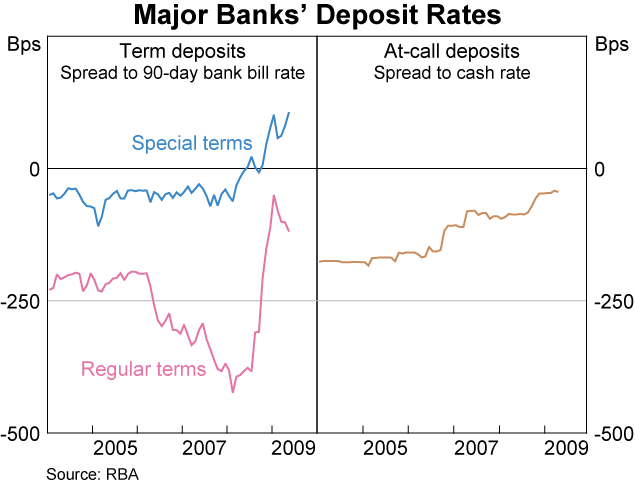
Short-term capital market debt
Short-term capital market debt is priced mainly off the 30-day and 90-day bank bill rates. Prior to mid 2007, bank bill rates closely tracked the market's expectation for the cash rate (the overnight indexed swap or OIS rate) with the spread between 90-day bank bills and 90-day OIS remaining stable at around 10 basis points (Graph 2). But the increase in risk aversion since the onset of the capital market turbulence has caused bank bill rates to rise well above OIS rates. The spread between the two series rose from 30 basis points to 100 basis points in September last year, but has since returned to around 30 basis points. As the bank bill/OIS spread has not changed in net terms since last September, the cost of bank bill funding has broadly fallen in line with the cash rate since then.
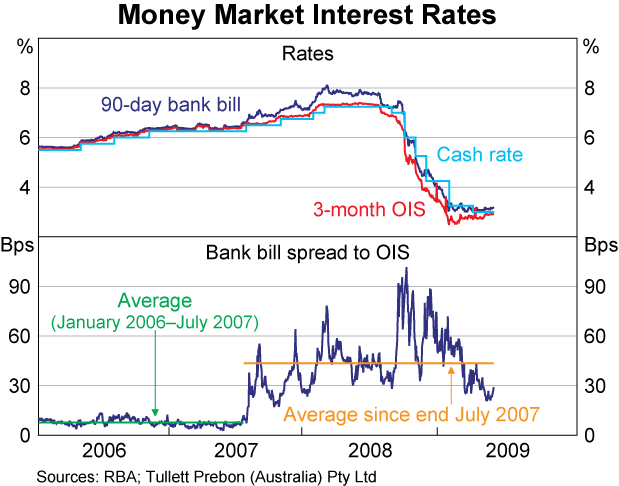
Long-term capital market debt
Long-term capital market debt accounts for a little under a quarter of major banks' total funding. The interest rate on long-term bonds issued in Australia and overseas reflects the 90-day bank bill rate (or the swap rate for fixed-rate bonds) plus a fixed spread for issuing at term, plus any hedging costs. In addition to the increase in the spread between bank bill rates and OIS described above, the spread over bank bills/swap on the major banks' 3-year bonds (about the average initial maturity of new debt) has risen from about 15 basis points in mid 2007 to around 120 basis points, as greater risk aversion has seen investors demand larger risk premia to provide term funding. The cost of hedging foreign currency debt has also risen noticeably. The increase in bond spreads and hedging costs has offset some of the large falls in the bank bill rate and 3-year swap rate, which were driven by the reduction in the cash rate. Nevertheless, the interest rates on new variable and new fixed-rate bank bonds are about 370 and 200 basis points, respectively, lower than in September last year.
The average interest rate on banks' outstanding fixed-rate bonds (rather than the marginal cost) is a weighted average of the swap rates and bond spreads that prevailed when the bonds were first issued. The average interest rate on this debt rose steadily until late 2008, as bonds that were issued in 2005 and 2006 when swap rates and bond spreads were lower, were replaced with new debt issued at higher rates (Graph 3). During the first half of 2009, the average interest rate fell slightly, as the newly issued bonds had lower interest rates than the maturing bonds.
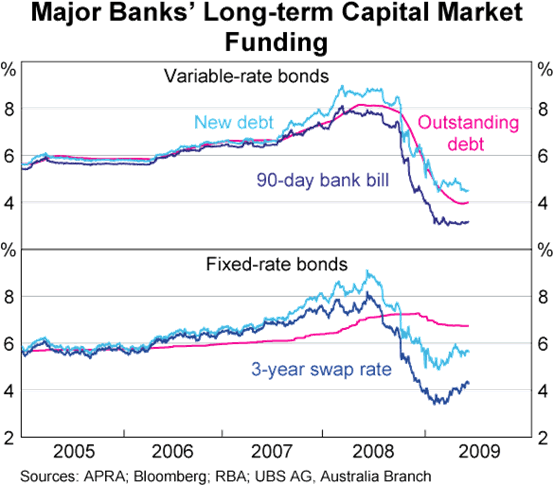
The average interest rate on banks' outstanding variable-rate bonds is equal to the current 90-day bank bill rate plus a weighted average of the bond spreads that prevailed when the bonds were first issued. The average interest rate on this debt rose steadily up until mid 2008, as bank bill rates increased, and bonds that were issued at low spreads matured and were replaced with new bonds issued at higher spreads. Since then the average interest rate has fallen significantly, as the sharp decline in the 90-day bank bill rate (driven by the reduction in the cash rate) has outweighed the effect of the higher bond spreads.
The swap spreads that Australian banks pay to hedge their foreign currency debt back into Australian dollars have also risen sharply since mid 2007. As discussed in Appendix A, normally it costs banks about 5–10 basis points to hedge their foreign currency denominated debt back into Australian dollars, but during the capital market turbulence hedging costs have been very volatile, reaching as high as 70 basis points in April 2009. The cost of issuing long-term debt offshore is normally similar to the cost of issuing in Australia, with slightly lower bond spreads on the offshore debt offsetting the hedging costs. However, over the past few months, the higher hedging costs have meant that US dollar-denominated offshore debt has been at least 20 basis points more expensive than domestic debt. However, the average swap spread is only indicative of the cost, as the banks look to swap the funds back opportunistically when the spread is more favourable to them.
Overall, the average cost of banks' outstanding fixed and variable long-term debt is currently about 90 basis points higher, relative to the market's expectation for the cash rate, than it was in mid 2007. If bond spreads and hedging costs remain around their current levels, then as maturing bonds are rolled over, the average spread on banks' outstanding long-term debt would increase by about 40 basis points over the next year and a half and stabilise thereafter. However, long-term debt accounts for only a quarter of banks' total funding, so the effect on their overall funding costs is much smaller, at about 7 basis points a year.
Other capital market funding
Residential mortgage-backed securities (RMBS) account for only 2 per cent of major banks' existing funding, with a cost equal to the 30-day bank bill rate plus a spread, which is fixed at issuance. The major banks have not issued any RMBS since the onset of the capital market turbulence as many domestic and foreign investors have had little appetite for new issues, and the major banks have access to other cheaper sources of funding. The absence of the RMBS market has had only a minimal effect on the funding costs of the major banks but has had a significant effect on those more reliant on this means of funding, particularly non-bank lenders.
Over the past year, the major banks have also raised equity and hybrid capital to support their lending growth and strengthen their capital ratios in anticipation of continued volatile economic conditions. This additional capital has been more expensive for the banks as share prices have fallen sharply and spreads on hybrid securities have risen significantly.
Overall funding costs
Taking into account the costs of individual funding sources noted above, and weighting them by the share of total bank funding, allows an estimate of the overall change in banks' funding costs. Data are available on the shares of banks' funding at an aggregate level for deposits, short-term debt, long-term debt, securitisation and equity. Interest rates on the different types of capital market funding are reasonably similar across markets for equivalently rated banks and are readily observable. In contrast, the interest rates on banks' various deposit products differ noticeably, and there is a lack of publicly available data on changes in the composition of banks' deposits. As deposits make up half of banks' total funding, and competition for deposits has been fierce over the past year or so, it is not possible to be precise about their impact on funding costs. Nevertheless, a reasonable approximation is that the composition of deposit funding has been relatively stable. On this basis, we estimate that the interest rate on major banks' outstanding funding liabilities has declined by an average of about 330 basis points since the first reduction in the cash rate in September last year (Graph 4). This is about 95 basis points less than the fall in the cash rate over the same period.
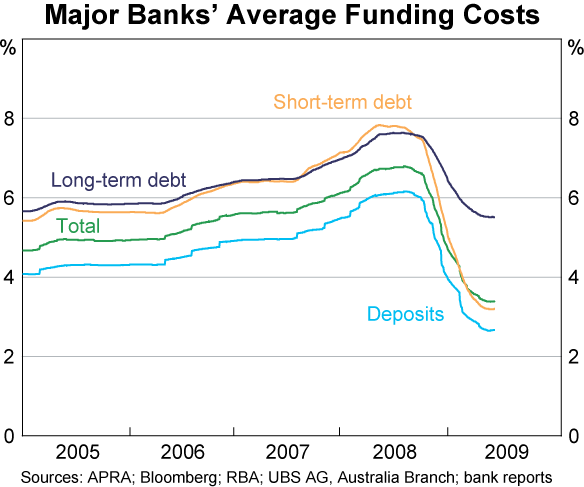
Banks' Lending Rates and Interest Margins
In setting interest rates on loans, banks take into account changes in their overall cost of funds. Over much of the past decade, with market conditions stable, banks' overall cost of funds tended to follow the cash rate, and therefore banks tended to adjust their lending rates mainly in response to changes in the cash rate. The relationship between the cash rate and the rate on standard housing loans was particularly close from 1999 to 2007, though in the longer sweep of history this period looks unusual. While the standard variable indicator rate was adjusted with the cash rate through this period, the actual rate paid by borrowers had a looser relationship, with banks steadily increasing the discounts on new loans. The average variable rate paid by business borrowers also declined (by about 1 percentage point) relative to the cash rate over the decade (Graph 5).
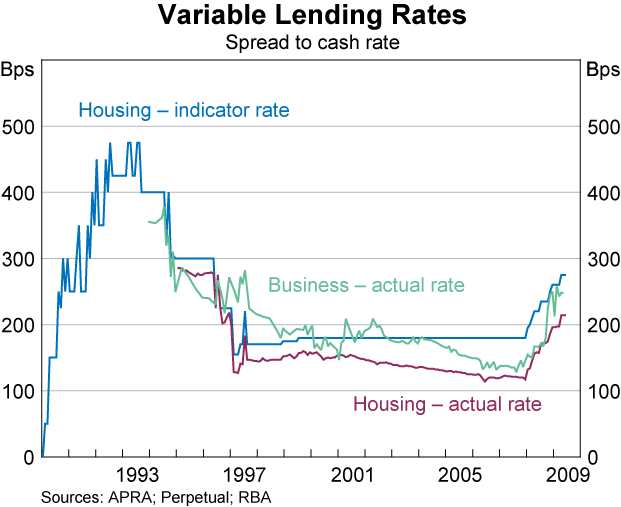
As described above, the recent financial market turbulence has increased banks' funding costs relative to the cash rate and this has been reflected in their lending rates. It is estimated that the major banks have reduced their variable housing lending rate by an average of 385 basis points since September 2008. This is less than the reduction in the cash rate of 425 basis points, but more than the reduction in their average funding costs of 330 basis points.
The weighted-average interest rate on the major banks' outstanding housing loans has fallen by around 290 basis points, less than the reduction in the variable housing rate, reflecting the fact that over 20 per cent of housing loans are at fixed rates. Interest rates on personal loans to households have fallen by 170 basis points (Graph 6).
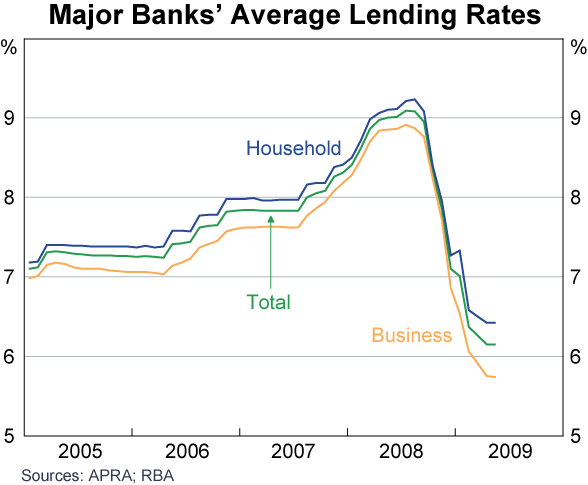
Variable interest rates on small business loans have fallen substantially less than housing loan rates. There have been smaller cuts in indicator rates and increased risk margins for some individual borrowers. For fixed-rate loans to small businesses, spreads over swap rates have also risen. Overall, the weighted average cost of small business loans has fallen by 230 basis points since September 2008.
Variable-rate loans to large businesses are typically referenced to the current bank bill rate, with an additional risk margin that reflects the perceived riskiness of the borrower, and is fixed for the life of the loan. Banks now view the margins on loans written during the middle of this decade as being too low given the risks involved. Over the next few years, as loans written during 2005–2007 mature, they are likely to be refinanced at higher risk margins. This is a gradual process; over the past year, banks have repriced about one-third of their outstanding large business loans. Overall, the average interest rate on outstanding large business loans has decreased by 350 basis points since last September. This is a larger decline than that on small business loans because a larger proportion of large business loans are at variable rather than fixed rates and, to date, only some of these loans have been repriced to account for higher risk margins.
This decrease in the average lending rate across business loans is less than the decline in average funding costs. Partly this is offsetting the fact that variable housing loan rates have fallen more than the cost of funds, but it also reflects some increase in risk margins. Information published by the major banks in their financial statements on net interest margins (NIM) for their Australian operations shows that, in the half-year to March 2009, the average NIM was 9 basis points higher than in the previous half (Graph 7).[4] The latest increase follows a 5 basis point rise in the half-year to September 2008. The major banks' NIM currently averages 2.27 per cent, which is a little above the level before the onset of the financial market turbulence in mid 2007.
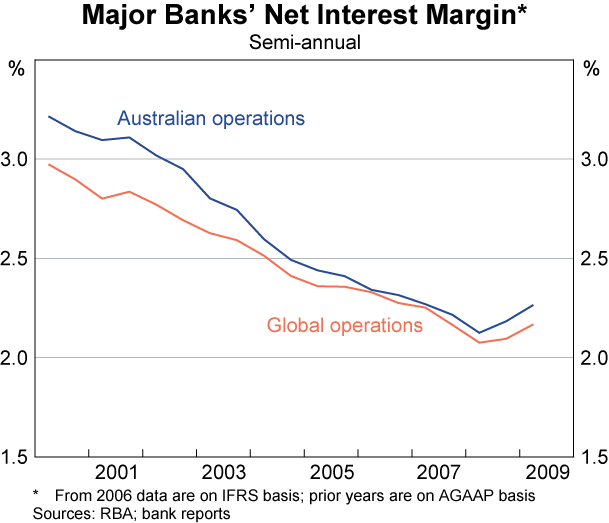
Recent trends in the NIM contrast with the prior decade when the NIM tended to decline by about 10 basis points per year. This trend decline related to reduced spreads on some loan products and compositional changes in banks' loans and funding, such as household and business customers shifting to loan and deposit products with lower margins, a shift in the lending mix from business to housing loans and the increased use of (higher cost) capital market funding. The banks were able to accommodate this declining NIM by reducing their costs – in part through economies of scale as their lending grew rapidly – so that their banking profits did not also experience a trend decline. The decline in the NIM since 2004 had been at a slower rate than earlier in the decade, suggesting that the rate of trend decline may have been coming to an end.
Conclusion
For much of the past decade, banks' funding costs have tended to move in line with the cash rate, to a large extent reflecting stable conditions in financial markets. As a result, a market practice developed whereby variable rates on small business and household loans closely tracked the cash rate. This was not the case prior to this period, with banks' lending rates being varied independently of the cash rate.
The recent financial turbulence means that, while the cash rate remains a key influence on banks' funding costs, the costs of the various forms of banks' funding have not fallen as much as the cash rate due to an increase in term premia and credit and liquidity spreads. Banks have cut variable housing loan rates more than the fall in their cost of funds, but reductions in business lending rates have been less. Overall, banks' net interest margins have risen a little recently, offsetting the fall that occurred in the early part of the financial crisis.
Appendix A: Hedging Foreign Currency-Denominated Debt
For many years, the Australian banks have sourced some of their funding from offshore capital markets. Most of this is long-term funding, denominated in foreign currencies. However, the Australian banks are not exposed to exchange rate or interest rate risk from their offshore debt because they hedge it back into Australian dollars at the time of issuance.[5] The banks are able to do this because there is significant demand for Australian dollar assets from non-residents.
The hedging of foreign currency debt back into Australian dollars can involve several steps. First, the bank sometimes enters into an interest rate swap to hedge the semi-annual bond coupons against 3-month LIBOR. This involves the bank paying 3-month LIBOR plus a spread and receiving 6-month LIBOR.
Second, the bank enters into cross-currency interest rate swaps to convert the foreign currency interest payments into Australian dollar interest payments. These cross-currency interest rate swaps are usually referenced against the US dollar. So if the bank is hedging US dollar debt, it only needs to enter into an AUD/USD cross-currency interest rate swap, where it pays 3-month Australian dollar bank bill rate plus a spread and receives 3-month US dollar LIBOR. But if it is hedging debt denominated in other foreign currencies, it needs to enter into two cross-currency interest rate swaps. The first hedges the foreign currency into US dollars, and involves the banks paying 3-month US dollar LIBOR and receiving the foreign currency 3-month LIBOR plus a spread. The second hedges the US dollar payments into Australian dollars, and involves the bank paying the 3-month Australian dollar bank bill rate plus a spread and receiving 3-month US dollar LIBOR.
During normal capital market conditions, these foreign exchange and interest rate swaps markets are quite deep and liquid, and hence the banks can hedge their foreign currency debt reasonably easily, and at a fairly predictable cost. Moreover, much of these hedging costs are offset by lower bond spreads on debt issued offshore.[6] But since the onset of the market turbulence in mid 2007, and especially over the past six months, swaps markets have been much less liquid, and this has resulted in volatile swap rates and wide bid/ask spreads.
For a 3-year bond, which is about the average maturity of Australian banks' new issuance, the annual cost of the interest rate swap for US dollar and euro denominated debt is currently around 20 and 10 basis points respectively, compared with an average of 5 basis points between August 2007 and September 2008, and zero basis points before the onset of the capital market turbulence (Graph A1). The cost of cross-currency interest rate swaps for hedging major currencies back into Australian dollars has also been highly volatile since March 2008, and for the euro, UK pound and Japanese yen, has risen sharply since August 2008 to about 55 basis points per annum, up from about 5–10 basis points prior to mid 2007. (The small premium that was evident prior to mid 2007 has been evident for many years, and is due to there being more demand to pay Australian dollar interest rates and receive foreign currency interest rates.) Indicative rates for the cost of hedging US dollar debt into Australian dollars have risen to about 25 basis points.
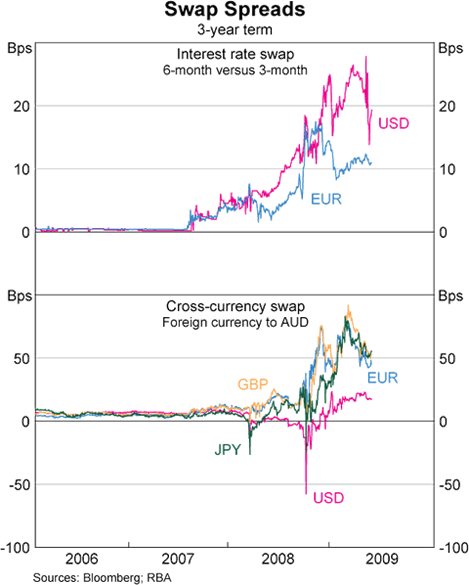
The volatility in interest rate and foreign exchange swaps markets has clearly made it more costly for Australian banks to hedge their foreign currency debt. However it is difficult to precisely quantify the effect on banks' funding costs as hedging costs can vary significantly depending on the currency and the term of the debt being hedged. Over recent months, the pricing of interest rate and cross-currency swaps has also varied significantly from one day to the next. The banks try to minimise their hedging costs by timing their hedging of their foreign currency borrowings to obtain the most favourable pricing.
Footnotes
This article was prepared by Michael Davies, Chris Naughtin and Arlene Wong of Domestic Markets Department. The data in this article are until end May 2009. [1]
Uridashi are Australian dollar-denominated bonds issued to retail investors in Japan by non-residents. Samurai bonds are yen-denominated bonds issued in Japan by non-residents. Extendible bonds have an initial maturity of 13 months and thereafter have a rolling maturity of 12 months, which is extendible at the option of the investor with one month's notice, and a final maturity of 5 or 6 years. [2]
The bank swap rate is the base interest rate for many fixed-rate bonds in Australia. It is the fixed rate one party is willing to pay in exchange for receiving the average bank bill rate over the term of the swap. [3]
The NIM is the difference between the average interest rate paid on a bank's assets (mostly loans, but also other debt securities) and the interest paid on its liabilities (deposits, debt and equity), expressed as a percentage of its interest-earning assets. CBA's financial year ends in June. We have adjusted its reported NIM to align it with the other three major banks, whose financial years end in September. [4]
See Becker C, G Debelle and D Fabbro (2005), ‘Australia's Foreign Currency Exposure and Hedging Practices’, RBA Bulletin, December, pp 1–8. [5]
See Reserve Bank of Australia (2006), ‘Australian Banks' Global Bond Funding’, Bulletin, August, pp 1–6. [6]